| Author |
Message |
|
Jean-Carle Hudon
|
 Posted: Sat 29 Jan, 2011 9:06 am Post subject: del tin lombard or vendel swede Posted: Sat 29 Jan, 2011 9:06 am Post subject: del tin lombard or vendel swede |
 |
|
Hello Kirk,
in your Behmer classification, he shows a ring hilt in type 6, circa 600-750 as a Vendel model from Sweden, I have that model from Del Tin as a lombard of the seventh century, no 2071. They agree on time frame, but not on provenance? Any comments as to where that particular find was made ?
Also I am working on a scabbard , any suggestions on the belting , seems it should de lower as per the drawing posted at the start of this thread. Again, variations?
Thanks for your input. JC
Bon coeur et bon bras
|
|
  |
 |
|
Stephen Curtin
|
 Posted: Mon 31 Jan, 2011 12:56 am Post subject: Posted: Mon 31 Jan, 2011 12:56 am Post subject: |
 |
|
Hi Jean-Carle I'm not Kirk, but I might still be able to help you out. After a quick search I was able to find at least one reference to a lombardic sword with a ring hilt, it was found in Nocera Umbra grave 32, but unfortunately I have no images of it though.
Éirinn go Brách
|
|
   |
 |
Kirk Lee Spencer

|
 Posted: Mon 31 Jan, 2011 8:37 am Post subject: Re: del tin lombard or vendel swede Posted: Mon 31 Jan, 2011 8:37 am Post subject: Re: del tin lombard or vendel swede |
 |
|
| Jean-Carle Hudon wrote: | Hello Kirk,
in your Behmer classification, he shows a ring hilt in type 6, circa 600-750 as a Vendel model from Sweden, I have that model from Del Tin as a lombard of the seventh century, no 2071. They agree on time frame, but not on provenance? Any comments as to where that particular find was made ?...
JC |
Hi Jean-Carle...
The example in the chart is from Valsgarde Sweden (grave 7). I have attached larger images showing the full length of the sword and more detail.
[Not sure on the scabbard location. I have seen images and drawings of migration swords in grave find loction that have them both high (under the arm) and low (near the hip).]
take care
ks
 Attachment: 130.1 KB Attachment: 130.1 KB
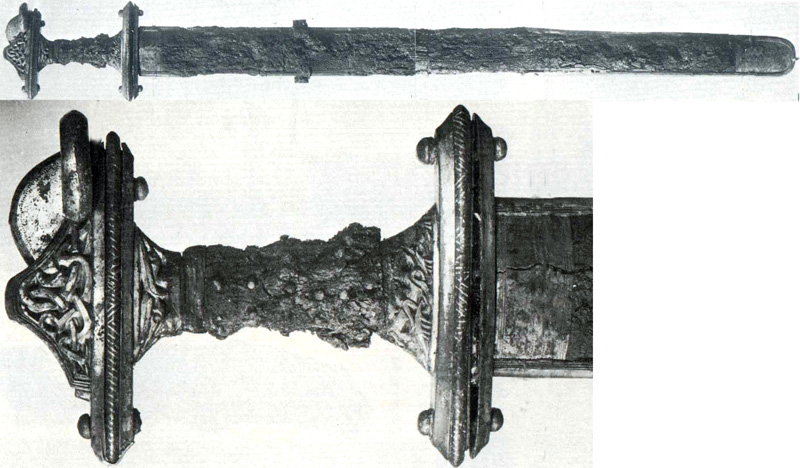
 Attachment: 142.14 KB Attachment: 142.14 KB
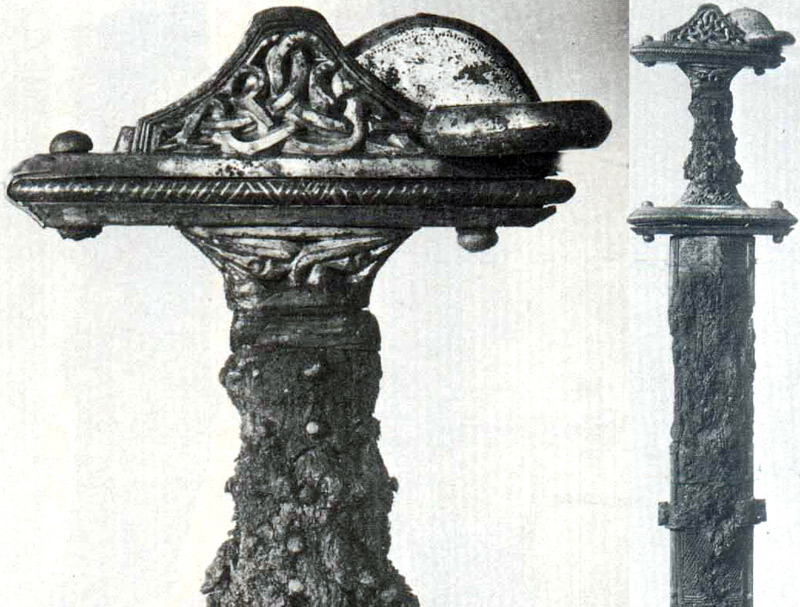
Two swords
Lit in Eden’s flame
One of iron and one of ink
To place within a bloody hand
One of God or one of man
Our souls to one of
Two eternities
|
|
  |
 |
Kirk Lee Spencer

|
 Posted: Mon 31 Jan, 2011 9:05 am Post subject: Posted: Mon 31 Jan, 2011 9:05 am Post subject: |
 |
|
| Stephen Curtin wrote: | | Hi Jean-Carle I'm not Kirk, but I might still be able to help you out. After a quick search I was able to find at least one reference to a lombardic sword with a ring hilt, it was found in Nocera Umbra grave 32, but unfortunately I have no images of it though. |
Good spot Stephen...
The Del Tin may be a replica of one of the swords from the cemetery at Nocera Umbra Italy.
I have attached images of two of these swords. First, the one you mentioned from Grave 32
and another one from Grave 1.
take care
ks
 Attachment: 99.3 KB Attachment: 99.3 KB
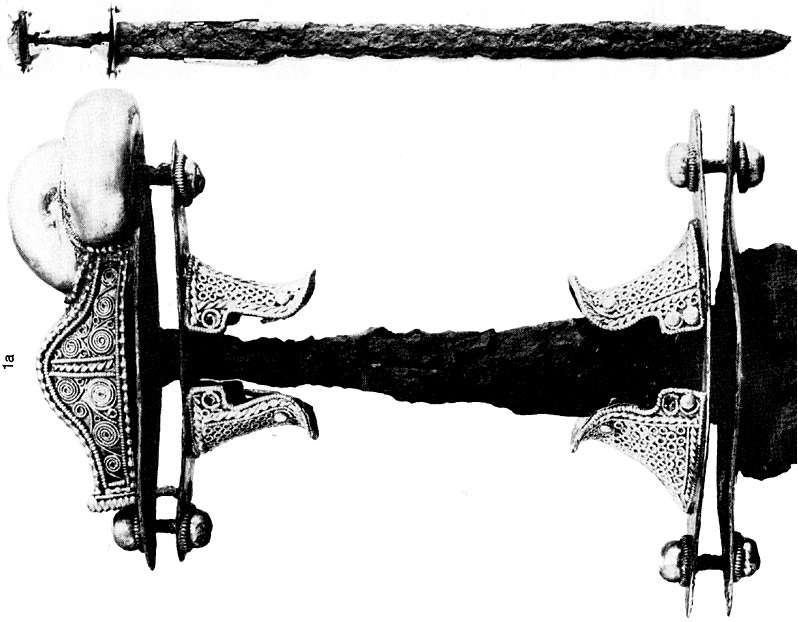
Find Location Grave 32. Nocera Umbra Italy. Overall Length 92cm Max blade width 60mm. Image from "Das Schwert im Fruhen Mittelalter" by Wilfried Menghin
 Attachment: 98.34 KB Attachment: 98.34 KB
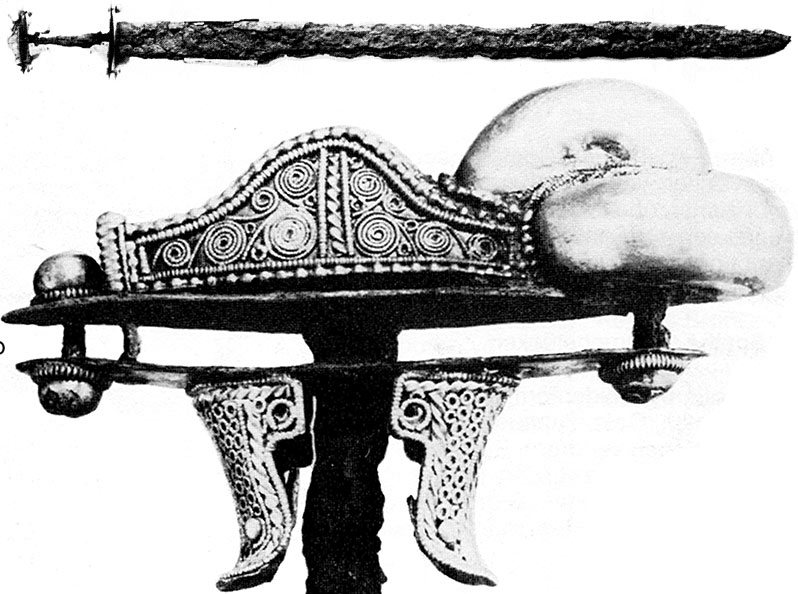
Find Location Grave 32. Nocera Umbra Italy. Overall Length 92cm Max blade width 60mm. Image from "Das Schwert im Fruhen Mittelalter" by Wilfried Menghin
 Attachment: 99.79 KB Attachment: 99.79 KB
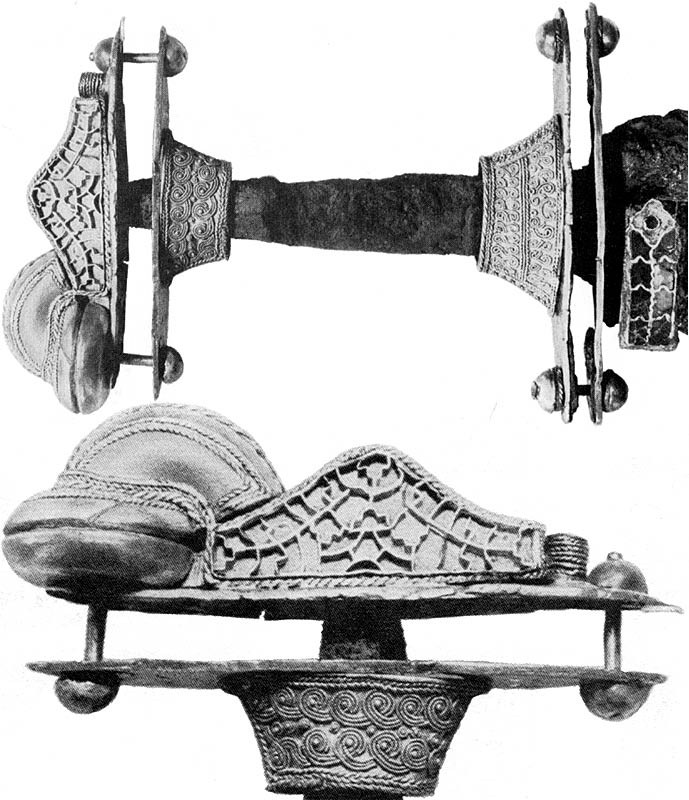
Find Location Grave 1. Nocera Umbra Italy. Image from "Das Schwert im Fruhen Mittelalter" by Wilfried Menghin
 Attachment: 146.99 KB Attachment: 146.99 KB
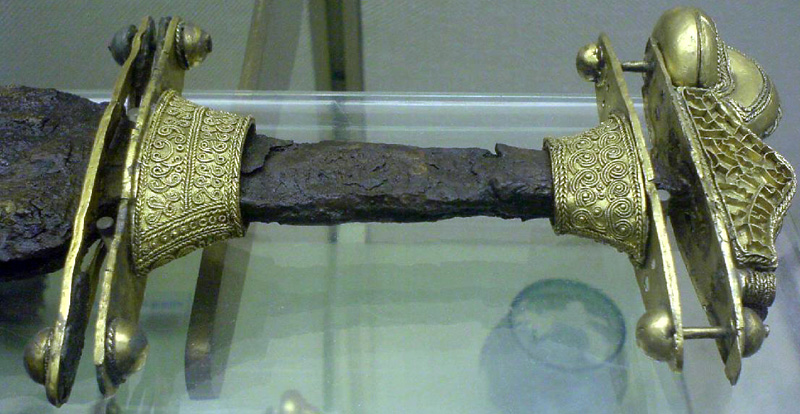
Find Location Grave 1. Nocera Umbra Italy.
Two swords
Lit in Eden’s flame
One of iron and one of ink
To place within a bloody hand
One of God or one of man
Our souls to one of
Two eternities
|
|
  |
 |
|
Antonio Lamadrid
|
 Posted: Mon 31 Jan, 2011 9:46 am Post subject: Posted: Mon 31 Jan, 2011 9:46 am Post subject: |
 |
|
DT 2071 is inspired by the Trezzo sull'Adda Sword.
As far as I know this one plus the two from Nocera Umbra are the only three ring-hilt swords found in Italy.
Pics taken from L'Esercito Longobardo 568-774. By Marco Balbi, Editrice Militare Italiana.
 Attachment: 175.76 KB Attachment: 175.76 KB
[ Download ]
 Attachment: 194.19 KB Attachment: 194.19 KB
[ Download ]
|
|
  |
 |
|
Jean-Carle Hudon
|
 Posted: Mon 31 Jan, 2011 4:18 pm Post subject: swede & lombard Posted: Mon 31 Jan, 2011 4:18 pm Post subject: swede & lombard |
 |
|
Great information ! The engravings surely mimic those of the Trezzo Adda, though Signor Del Tin chose a brass medium instead of a silver finish. Isn't it something though that these finds are so similar, no significant difference between them as far as I can see ! So I guess I can imagine a summer kit as a Lombard lord and a winter kit as a fur wearing Swede...
Thanks Kirk, Stephen and Antonio. JC
Bon coeur et bon bras
|
|
  |
 |
|
Stephen Curtin
|
 Posted: Fri 25 Feb, 2011 2:25 pm Post subject: Posted: Fri 25 Feb, 2011 2:25 pm Post subject: |
 |
|
Hi everyone I'm still looking for info on the vieuxville type pommel, if anyone here could tell me more about them it would be much appreciated.
Éirinn go Brách
|
|
   |
 |
|
Till J. Lodemann
|
 Posted: Tue 01 Mar, 2011 12:00 pm Post subject: Posted: Tue 01 Mar, 2011 12:00 pm Post subject: |
 |
|
Hi Stephen! I would like to help you, but in the moment I'm busy at an excavation and am not able to visit the library - it would be good to look into Miks' book for this and your other question. Maybe I can look at some of my notes the next days and find out more about the vieuxville type pommelcaps.
Regards,
Till
|
|
  |
 |
|
Stephen Curtin
|
 Posted: Tue 01 Mar, 2011 12:26 pm Post subject: Posted: Tue 01 Mar, 2011 12:26 pm Post subject: |
 |
|
As always Till, thank you very much for your efforts.
Éirinn go Brách
|
|
   |
 |
|
Stephen Curtin
|
 Posted: Fri 26 Aug, 2011 11:23 am Post subject: Posted: Fri 26 Aug, 2011 11:23 am Post subject: |
 |
|
Ok so I've been thinking about this one again and I've come up with a new theory. Well maybe not a whole new theory, but a new perspective. This came about when I was looking again at Patrick Barta's website. I noticed that his example of a Behmer type II (no. 101 Roman riding sword), which does not have any sort of pommel or peen block, has rivets holding the parts of the guards together, or rather holding the bronze plating in place. I then noticed a picture of his gold hilt spatha before assembly, and it seems to be constructed in the exact same fashion as the above sword, the only difference being that the plate which covers the top of the upper guard also forms the pommel. If we compare Barta's gold hilt spatha to an early example of Behmer type IV we can see that the plates covering the sides of the guards have been removed, leaving the underneath organic material exposed, but the plates at the top and bottom of the guards are kept. Perhaps as pommels grew larger it was easier to make them seperately from the top plate of the upper guard, and rivet them onto it instead. So what do the rest of you guys think of this?
Éirinn go Brách
|
|
   |
 |
|
Len Parker
|
 Posted: Fri 26 Aug, 2011 12:57 pm Post subject: Posted: Fri 26 Aug, 2011 12:57 pm Post subject: |
 |
|
Stephen, did you see this image of the construction of the riding sword. http://www.templ.net/pics-making/hilts/photo01v.jpg. You can see the peening block set in the top of the guard. It's hidden by the plates.
I'm not sure why they didn't have the tang going through the pommel during this period. Maybe they were just used to making the tang short?
Stephen did you get any new info on the vieuxville pommels? Ever since Till labeled them roman I've been anxious for more.
|
|
  |
 |
|
Stephen Curtin
|
 Posted: Fri 26 Aug, 2011 3:14 pm Post subject: Posted: Fri 26 Aug, 2011 3:14 pm Post subject: |
 |
|
Hi Len, yes I have seen this pic before, in fact it is one of the pics that inspired my last post. If you compare this one to the pic of his gold hilt spatha before assembly, the two are almost identical, except for the top plate on the upper guard. The roman riding sword is flat, while the gold hilt spatha is shaped to include a small pommel cap, and as I said above I think this might be a transitional form leading to Behmer type IV.
Éirinn go Brách
|
|
   |
 |
|
Stephen Curtin
|
 Posted: Fri 26 Aug, 2011 4:54 pm Post subject: Posted: Fri 26 Aug, 2011 4:54 pm Post subject: |
 |
|
Hi again Len, sorry I forgot to answer about the vieuxville pommel type. Unfortunately no, I haven't come across any more info about them, but I'm still hoping someone will come along here and enlighten us someday. I also find these interesting, as they may be the key to another possible theory for the development of migration period pommels. AFAIK they first appear around 400AD on the Behmer type I, like the horn hilts from Nydam, they are also seen on the type V, and at least one of these that I've seen, seems to have had the tang peened over it, as well as riveted to the upper guard. It may be that they started out as a peen block on swords with guards of organic material, but when they were used on guards with riveted metal components, it only made sense to rivet the whole way through the upper guard and pommel. Then after time it might have been seen as redundant to peen them to the tang as well as rivet them to the guard, so they were just riveted.
Éirinn go Brách
|
|
   |
 |
|
Len Parker
|
 Posted: Fri 26 Aug, 2011 5:41 pm Post subject: Posted: Fri 26 Aug, 2011 5:41 pm Post subject: |
 |
|
|
Ever since Till J. Lodemann posted this about the vieuxville pommel "This type, was found in the whole limes region from the Netherlands to the Danube delta. Mainly in burgi and castles." I've hoped for more information. The late roman 5thc. spatha has always been a bit of a mystery to me.
|
|
  |
 |
|
Stephen Curtin
|
 Posted: Fri 30 Dec, 2011 2:53 pm Post subject: Posted: Fri 30 Dec, 2011 2:53 pm Post subject: |
 |
|
In the second post of this thread, Paul Hansen theorised that the pommels types from the Sutton Hoo and Vendel finds might have developed from the earlier Tournai and Blunica types. Well recently I noticed a pommel from the Staffordshire hoard which could be a transitional form between the above two types.
finds.org.uk/staffshoardsymposium/papers/svantefischerandjeansoulat
If you look on the right hand side of the last picture in group C, you will see the pommel which I'm talking about. It has the cocked hat shape of the Sutton Hoo and Vendel examples, but also has a garnet cloisonne upper guard similar to the Tournai sword. Also of interest is that it seems to have had a ring attachment which is now missing.
Éirinn go Brách
|
|
   |
 |
Jared Smith

|
 Posted: Fri 30 Dec, 2011 8:46 pm Post subject: Posted: Fri 30 Dec, 2011 8:46 pm Post subject: |
 |
|
| Kirk Lee Spencer wrote: |
I have attached images of two of these swords. First, the one you mentioned from Grave 32
and another one from Grave 1.
|
Thanks for posting the second one. The color photo makes the original style of decoration more obvious. Something not obvious from all of the black and white groupings of "migration era" types is that a great deal many of the nicer migration era swords were decorated with garnet cloisonne. Many of us tend to focus on the shape and construction of the furniture, but the ornamentation is actually more specific to "post Roman empire, Pre- formal, Danish, Viking era" with pretty minimal overlap compared to overlap with pommel forms and construction. The cloisonne sort of typifies Merovingian era art including the nicer swords we have enough to tell about surface deoration. I take an interest in it because the known origins of the types of blood red garnets were very specific in terms of geography. (Generally close to Poland.)
Absence of evidence is not necessarily evidence of absence!
|
|
  |
 |
|
|

